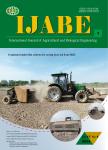Optimization of equitable irrigation water delivery for a large-scale rice irrigation scheme
作者机构:Department of Biological and Agricultural EngineeringFaculty of EngineeringUniversiti Putra Malaysia(UPM)UPM Serdang 43400Selangor DEMalaysia Department of Agricultural Engineering and TechnologyFaculty of Agricultural SciencesGhazi UniversityDera Ghazi KhanPakistan Department of Irrigation and Water ManagementFaculty of Agricultural Engineering and TechnologyBangladesh Agricultural UniversityMymensingh 2202Bangladesh Faculty of Sustainable AgricultureUniversiti Malaysia Sabah(UMS)Jalan UMSKota Kinabalu 88400SabahMalaysia Department of Civil EngineeringFaculty of EngineeringUniversity of MalayaKuala Lumpur 50603Malaysia
出 版 物:《International Journal of Agricultural and Biological Engineering》 (国际农业与生物工程学报(英文))
年 卷 期:2018年第11卷第5期
页 面:160-166页
核心收录:
基 金:Ministry of Science Technology and Innovation Malaysia
主 题:irrigation optimization simulation equitable deliveries rice
摘 要:Equitable water allocation is essential in an irrigation scheme for obtaining potential crop yields from the entire scheme,especially when water supply is *** optimization model achieved this goal by coupling an optimal water allocation model with available water supply and irrigation water demand for a river-fed rice irrigation system in *** model consists of a paddy field water balance module and an optimization *** outputs from the module are daily irrigation demand and surface runoff,if there is *** optimization module consists of an objective function,which minimizes water shortage across the scheme area while maintaining equity in water *** model performs optimization subject to several system constraints,and the decision variable of the model is daily releases or supply to the tertiary *** of this model remained unaffected under different water supply conditions,and the optimization model reliably examined the effects of alternate water allocation and management rules with field *** improves efficiency and equity in water allocation with respect to crop growth stages and water shortages rather than simply cutting irrigation supply on a proportional basis to overcome water shortages.



